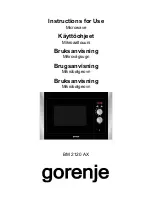
Microwave ovens cook food using microwave energy that is
similar to naturally occurring radio waves. Normally, these
"waves" would fade as they disappeared into the atmosphere
but in a microwave oven they are concentrated onto food
causing it to heat up.
Microwave energy can't pass through metal – so it can't
escape from inside your microwave oven – but it can pass
through materials like glass, porcelain, plastic and paper.
These are the things used to make
microwave-safe cooking
equipment.
Microwave-safe cooking equipment will still get hot as the
food it contains heats up.
Checking your cooking utensils
Most heat-resistant, non-metallic cooking utensils are safe to use in your
microwave. If you're not sure you can use a utensil in your microwave,
follow this simple test:
1 Put the utensil into the oven next to a cup of water –
use a cup
that you know is microwave-safe. Close the door
2 Turn the microwave oven on for 30 seconds only.
3 At the end of the time, carefully check to see if the water has
warmed up.
If the water hasn't warmed up but the utensil has, the utensil is not
microwave-safe and should not be used in the oven.
Be careful when removing utensil from the microwave as it may be hot.
The microwave energy focuses on the moisture in the
food causing lots of tiny vibrations. The vibrations get so
great that the moisture – and the food – heat up.
7
Safety
Never use scratched,
cracked or damaged
glass in a microwave.
Damaged glass can
explode.
Safety
Never use equipment
made of metal, except
foil in your microwave
oven.
The microwave energy
can't pass through the
metal so it bounces off
and sparks against the
inside of the oven.
Stop the microwave straight
away if any equipment does
cause sparks.
Remember that some crockery
has a metal trim around the
edge. Even this trim can cause
sparks.
Introducing microwave
cooking








































